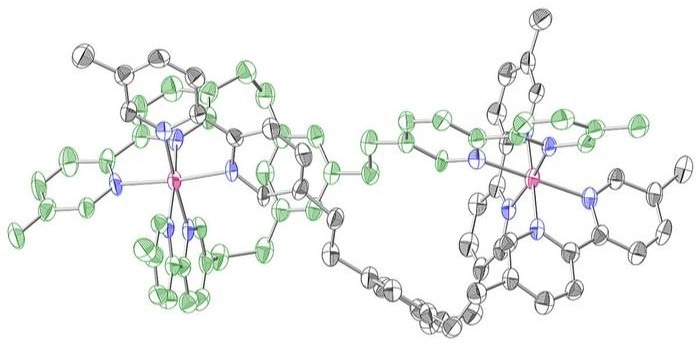The conversion and storage of solar energy into chemical energy, similar to the process of photosynthesis in plants, holds tremendous promise for tackling important energy and environmental concerns, such as the depletion of fossil fuels and the threat of global warming. One possible direction in this endeavor is to use light energy to transform CO2 into value-added chemicals.
 ORTEP drawing of the crystal structure of dinuclear ruthenium complex. Image Credit: University of Tsukuba
ORTEP drawing of the crystal structure of dinuclear ruthenium complex. Image Credit: University of Tsukuba
The researchers used the robust photocatalytic qualities of a ruthenium (Ru) dinuclear complex with self-photosensitizing capabilities to accomplish a highly effective CO2 reduction process in this study. This method produces an astonishingly high selectivity for carbon monoxide (CO).
After being exposed to light with a central wavelength of 450 nm in a 1 atm CO2 atmosphere for 10 hours, a dimethylacetamide/H2O mixture containing the Ru dinuclear complex as a photocatalyst and a sacrificial reducing agent consumed all of the sacrificial reducing agents and converted the substrate CO2 into CO with a selectivity that exceeded 99%.
It was found that the greatest quantum yield at 450 nm was 19.7%. Moreover, the photocatalytic CO2 reduction by the Ru complex proceeded with exceptional efficiency, demonstrating that nearly all of the introduced CO2 could be transformed into CO, even when the initial concentration of CO2 in the gas phase was lowered to 1.5%.
The two Ru complex moieties in this recently formed Ru dinuclear complex photosensitize, increasing the stability of the complex catalyst under reaction conditions. The ligand that was used has an incredibly potent chelating action, which is responsible for this increased stability.
To build a reaction system that can effectively drive the CO2 reduction process, even at a lower CO2 concentration equal to that of the Earth’s atmosphere, which is roughly 420 ppm, the researchers intend to improve the catalytic activity in the future.
This study was funded by a Grant-in-Aid for Transformative Research Areas (A) Green Catalysis Science for Renovating Transformation of Carbon-Based Resources (Green Catalysis Science) (JSPS KAKENHI grant no. JP23H04902) and Grants-in-Aid (nos. 21K18973 and 21H01947) from the Japan Society of Promotion of Science (JSPS, MEXT).
Journal Reference:
Ishizuka, T., et al. (2023) Self-Photosensitizing Dinuclear Ruthenium Catalyst for CO2 Reduction to CO. Journal of the American Chemical Society. doi:10.1021/jacs.3c07685